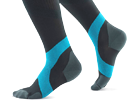| What Do Compression Socks Do?6 October 2015 | John Compression socks, as the name might suggest, provide compression to your lower leg and are a discrete alternative to compression stockings or tights. This has a number of benefits but the main one is that this compression boosts your circulation. Compression socks do this by helping the natural pumping action of the muscles in your lower leg, encouraging blood flow back to your heart. The pressure is strongest at your ankle and weakens as the sock goes up your leg, to help maximise blood flow. This has a number of great applications: Helping with Venous and Lymphatic DiseasesBy boosting the circulation in your leg, compression socks can help you deal with various venous and lymphatic conditions, which in turn helps the general health of your leg. For example, by increasing circulation compression socks can help control the symptoms of varicose veins, a venous condition where the valves in the veins which help maintain blood flow fail, causing the veins to swell. Compression socks can also help with lymphatic conditions such as lymphoedema, a condition where the body’s lymphatic system no longer drains excess fluid from tissue, causing them to swell. Compression therapy plays a large role in Decongestive Lymphatic Treatment (DLT), one of the most common treatments for lymphoedema as it helps to move fluid out of affected limbs and to control build-up. Improving Sports PerformanceBoosting circulation has two key benefits for athletes. Firstly, by increasing blood flow it’s believed that compression socks help to keep lactic acid moving in muscles, preventing it building up and causing pain, so you can train harder and for longer. Another application of compression socks in sport is recovery. Several studies, including this one in the British Journal of Sports Medicine and this one in the Journal of Strength and Conditioning Research in the USA have shown that compression garments, including compression socks, can aid in recovery post-exercise. They help reduce delayed onset muscle soreness (DOMS) so you don’t ache as much after a hard workout, and can also improve recovery time after hard athletics events such as marathons. It’s thought this is because the compression reduces the space available for muscles to swell. Preventing DVT on Long Haul FlightsCompression socks are also often used to help prevent the development of deep vein thrombosis (DVT) on long haul flights. It’s widely thought that long haul passengers are at a higher risk of DVT than they would be on the ground because of the long time spent sat in a cramped position. They even come recommended by the NHS. DVT is a clot in a vein deep in the body, and because compression socks help to boost circulation, they can help prevent blood pooling in your leg which is most at risk from DVT while flying because they are the least mobile part of your body during the flight. Before wearing compression socks you should first consult a doctor, so that you know they’re right for you. If you’re interested in getting your hands on some compression socks, head on over to Compression Stockings and check out our full range of Compression Socks. |







